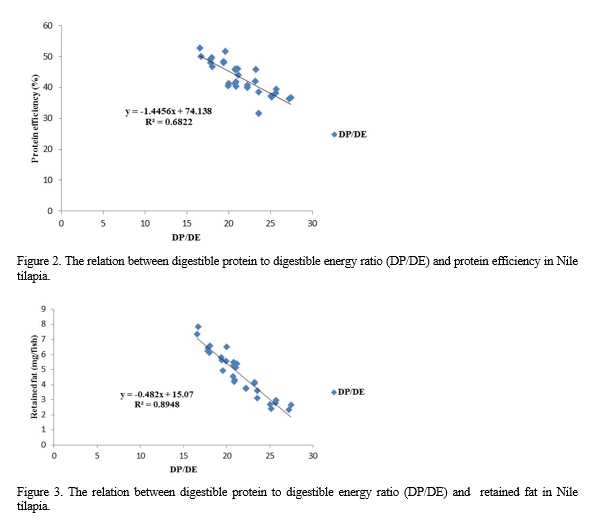IS THERE AN OPTIMAL DIETARY DP/DE RATIO FOR NILE TILAPIA?
Introduction
The variability in dietary ingredient composition of fish feed is expected to increase, due to the limiting amount of fishmeal and fish oil; the growth of the aquaculture sector and the competition for ingredients for biofuel production and terrestrial animal feeds. This increased variability will also coincide with a larger variability in digestibility of ingredients/nutrients. The ratio between digestible protein to digestible energy (DP/DE) is considered important for an optimal diet formulation. Generalizing over fish species, the optimal DP/DE ratio ranges between 17-23.8g/MJ. Most studies estimating this ratio are done at satiation feeding, resulting in the combined impact of both metabolism and feed intake on these estimates. Information on this ratio at restricted feeding levels in fish is lacking. Moreover, no experimental data on the optimal DP/DE ratio for Nile tilapia is available. This study assesses the optimal DP/DE ratio in Nile tilapia, when fed restrictively on the basis of equal amount of digestible protein.
Materials and method
Duplicate aquaria were randomly assigned to one of 16 diets. These diets were aimed to have a wide range in DP/DE ratio. DP levels ranged between 30 and 42% and DE levels between 16.0 and 20.5kJ/g. Fish were fed restrictively based on a similar predicted DP amount per day at all 16 diets. At the start of the experiment, all male Nile tilapia were randomly divided over 32 tanks of 70l. Per tank, 60 fish were stocked with an initial weight of 6.7g. All tanks were connected to one recirculation system and water quality was kept within the optimal range for tilapia. The experiment lasted 6 weeks. The first two weeks were used to allow the fish to adapt to the experimental diets. During the following 4 weeks faeces were collected per tank in order to calculate digestibility coefficients and to determine the energy and nitrogen balances.
Results
Figures 1 to 3 summarize the main finding on performance, energy and nitrogen balances. For none of the measured traits, there was an optimal DP/DE ratio found.
Discussion and conclusion
For all parameters measured, no optimum DP/DE ratio was found. Opposite to the expectation, the increase in growth with decreasing DP/DE ratio did not level off at low DP/DE ratios. Protein efficiency increased with declining DP/DE ratios, which agrees with the phenomenon of the protein sparing effect when the amount of non-protein energy is increased at high protein level. However, at very low DP/DE ratio, theoretically a levelling off in protein efficiency would be expected. This was not found in this study for Nile tilapia. The highest efficiency of digested protein was >50%, despite the fact that feeding levels at low DP/DE ratios were close to satiation feeding. The negative relation between fat retention and DP/DE ratio parallels other studies (Winfree and Stickney,1981; Saravanan et al., 2012). However, according to principle of the protein sparing effect, lowering the DP/DE ratio would first give no or a low increase in fat retention, and at lower DP/DE ratio the increase in fat retention should enhance with declining DP/DE ratios. However, in this study the relation between DP/DE and fat gain was linear over the full range of DP/DE studied. In conclusion, in 6 to 55g Nile tilapia no optimal DP/DE ratio were present.
References
Saravanan, S., Geurden, I., Figueiredo-Silva, A., Kaushik, S., Haidar, M., Verreth, J. and Schrama, J., 2012. Control of voluntary feed intake in fish: a role for dietary oxygen demand in Nile tilapia (Oreochromis niloticus) fed diets with different macronutrient profiles. British Journal of Nutrition, 108, 1519-1529.
Winfree, R. A. and Stickney, R. R., 1981. Effects of Dietary Protein and Energy on Growth, Feed Conversion Efficiency and Body Composition of Tilapia aurea. The Journal of Nutrition, 111, 1001-1012.

